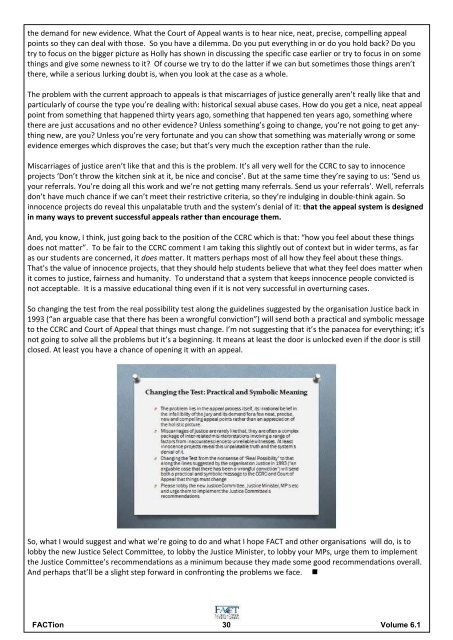FACTion-6.1-web-version
FACTion-6.1-web-version
FACTion-6.1-web-version
You also want an ePaper? Increase the reach of your titles
YUMPU automatically turns print PDFs into web optimized ePapers that Google loves.
the demand for new evidence. What the Court of Appeal wants is to hear nice, neat, precise, compelling appealpoints so they can deal with those. So you have a dilemma. Do you put everything in or do you hold back? Do youtry to focus on the bigger picture as Holly has shown in discussing the specific case earlier or try to focus in on somethings and give some newness to it? Of course we try to do the latter if we can but sometimes those things aren’tthere, while a serious lurking doubt is, when you look at the case as a whole.The problem with the current approach to appeals is that miscarriages of justice generally aren’t really like that andparticularly of course the type you’re dealing with: historical sexual abuse cases. How do you get a nice, neat appealpoint from something that happened thirty years ago, something that happened ten years ago, something wherethere are just accusations and no other evidence? Unless something’s going to change, you’re not going to get anythingnew, are you? Unless you’re very fortunate and you can show that something was materially wrong or someevidence emerges which disproves the case; but that’s very much the exception rather than the rule.Miscarriages of justice aren’t like that and this is the problem. It’s all very well for the CCRC to say to innocenceprojects ‘Don’t throw the kitchen sink at it, be nice and concise’. But at the same time they’re saying to us: ‘Send usyour referrals. You’re doing all this work and we’re not getting many referrals. Send us your referrals’. Well, referralsdon’t have much chance if we can’t meet their restrictive criteria, so they’re indulging in double-think again. Soinnocence projects do reveal this unpalatable truth and the system’s denial of it: that the appeal system is designedin many ways to prevent successful appeals rather than encourage them.And, you know, I think, just going back to the position of the CCRC which is that: “how you feel about these thingsdoes not matter”. To be fair to the CCRC comment I am taking this slightly out of context but in wider terms, as faras our students are concerned, it does matter. It matters perhaps most of all how they feel about these things.That’s the value of innocence projects, that they should help students believe that what they feel does matter whenit comes to justice, fairness and humanity. To understand that a system that keeps innocence people convicted isnot acceptable. It is a massive educational thing even if it is not very successful in overturning cases.So changing the test from the real possibility test along the guidelines suggested by the organisation Justice back in1993 (“an arguable case that there has been a wrongful conviction”) will send both a practical and symbolic messageto the CCRC and Court of Appeal that things must change. I’m not suggesting that it’s the panacea for everything; it’snot going to solve all the problems but it’s a beginning. It means at least the door is unlocked even if the door is stillclosed. At least you have a chance of opening it with an appeal.So, what I would suggest and what we’re going to do and what I hope FACT and other organisations will do, is tolobby the new Justice Select Committee, to lobby the Justice Minister, to lobby your MPs, urge them to implementthe Justice Committee’s recommendations as a minimum because they made some good recommendations overall.And perhaps that’ll be a slight step forward in confronting the problems we face. •<strong>FACTion</strong> 30 Volume <strong>6.1</strong>


